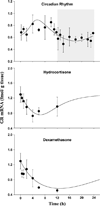Modeling circadian rhythms of glucocorticoid receptor and glutamine synthetase expression in rat skeletal muscle
- PMID: 16673181
- PMCID: PMC4178542
- DOI: 10.1007/s11095-005-9608-3
Modeling circadian rhythms of glucocorticoid receptor and glutamine synthetase expression in rat skeletal muscle
Abstract
Purpose: The circadian rhythm of endogenous corticosterone (CS) may produce fluctuations of downstream gene expression in normal rats. This study examined changes in glucocorticoid receptor (GR) and glutamine synthetase (GS) expression in rat skeletal muscle in relation to plasma CS over a 24-h period.
Methods: Fifty-four normal male Wistar rats were sacrificed at 18 time points (n = 3) over 24 h. Plasma CS concentrations and gastrocnemius muscle GR and GS mRNA and GS activity were measured.
Results: The circadian rhythm of plasma CS was captured by a two-harmonic function. The expression of GR and GS mRNA and GS activity follow a circadian rhythm in normal rat skeletal muscle. GR mRNA reaches a trough at 4 h after the peak of plasma CS and it fluctuates between 0.55 and 0.9 fmol g tissue(-1). GS mRNA and activity reach peaks at 6 and 12 h after the endogenous CS peak. GS mRNA oscillates between 3 and 6 fmol g tissue(-1), whereas GS activity fluctuates between 17 and 23 micromol min(-1) g protein(-1). Mechanistic receptor/gene-mediated pharmacodynamic models were applied to describe the temporal patterns of GR mRNA, GS mRNA, and GS activity within the circadian cycle.
Conclusions: The integrated models were able to capture the circadian expression patterns of plasma CS, and GR and GS in normal rat skeletal muscle showing a dependence of tissue gene expression on plasma CS.
Figures





Similar articles
-
Pharmacokinetic/Pharmacodynamic models for corticosteroid receptor down-regulation and glutamine synthetase induction in rat skeletal muscle by a Receptor/Gene-mediated mechanism.J Pharmacol Exp Ther. 1999 Feb;288(2):720-8. J Pharmacol Exp Ther. 1999. PMID: 9918581
-
Glutamine synthetase induction by glucocorticoids is preserved in skeletal muscle of aged rats.Am J Physiol. 1996 Dec;271(6 Pt 1):E1061-6. doi: 10.1152/ajpendo.1996.271.6.E1061. Am J Physiol. 1996. PMID: 8997226
-
Colorimetric detection of glutamine synthetase-catalyzed transferase activity in glucocorticoid-treated skeletal muscle cells.Anal Biochem. 2001 Feb 1;289(1):18-25. doi: 10.1006/abio.2000.4911. Anal Biochem. 2001. PMID: 11161290
-
Glutamine synthetase gene expression in the lungs of endotoxin-treated and adrenalectomized rats.Am J Physiol. 1997 Dec;273(6):L1182-90. doi: 10.1152/ajplung.1997.273.6.L1182. Am J Physiol. 1997. PMID: 9435573
-
Glucocorticoid-mediated induction of glutamine synthetase in skeletal muscle.Med Sci Sports Exerc. 1990 Jun;22(3):325-30. Med Sci Sports Exerc. 1990. PMID: 1974319 Review.
Cited by
-
Modeling of corticosteroid effects on hepatic low-density lipoprotein receptors and plasma lipid dynamics in rats.Pharm Res. 2008 Apr;25(4):769-80. doi: 10.1007/s11095-007-9371-8. Epub 2007 Aug 3. Pharm Res. 2008. PMID: 17674160 Free PMC article.
-
Modeling the effects of cell cycle M-phase transcriptional inhibition on circadian oscillation.PLoS Comput Biol. 2008 Mar 28;4(3):e1000019. doi: 10.1371/journal.pcbi.1000019. PLoS Comput Biol. 2008. PMID: 18369419 Free PMC article.
-
Pharmacokinetic/Pharmacodynamic Modeling of Dexamethasone Anti-Inflammatory and Immunomodulatory Effects in LPS-Challenged Rats: A Model for Cytokine Release Syndrome.J Pharmacol Exp Ther. 2023 Mar;384(3):455-472. doi: 10.1124/jpet.122.001477. Epub 2023 Jan 11. J Pharmacol Exp Ther. 2023. PMID: 36631280 Free PMC article.
-
Crosstalk between metabolism and circadian clocks.Nat Rev Mol Cell Biol. 2019 Apr;20(4):227-241. doi: 10.1038/s41580-018-0096-9. Nat Rev Mol Cell Biol. 2019. PMID: 30635659 Review.
-
Pharmacokinetics of methylprednisolone after intravenous and intramuscular administration in rats.Biopharm Drug Dispos. 2007 Sep;28(6):263-73. doi: 10.1002/bdd.551. Biopharm Drug Dispos. 2007. PMID: 17569107 Free PMC article.
References
-
- Retana-Marquez S, Bonilla-Jaime H, Vazquez-Palacios G, Dominguez-Salazar E, Martinez-Garcia R, Velazquez-Moctezuma J. Body weight gain and diurnal differences of corticosterone changes in response to acute and chronic stress in rats. Psychoneuroendocrinology. 2003;28:207–227. - PubMed
-
- Angelova KC, Angelov CG. Cosinor analysis of circadian oscillations of amino acid catabolizing enzymes in temporal pattern of nutrient input. Z. Ernahrungswiss. 1998;37(Suppl. 1):98–102. - PubMed
-
- Van Cantfort J, Gielen JE. Comparison of rat and mouse circadian rhythm of cholesterol-7 alpha-hydroxylase activity. J. Steroid Biochem. 1979;10:647–651. - PubMed
-
- Balsalobre A, Brown SA, Marcacci L, Tronche F, Kellendonk C, Reichardt HM, Schutz G, Schibler U. Resetting of circadian time in peripheral tissues by glucocorticoid signaling. Science. 2000;289:2344–2347. - PubMed
-
- Oakley RH, Cidlowski JA. Homologous down-regulation of the glucocorticoid receptor: the molecular machinery. Crit. Rev. Eukaryot. Gene Expr. 1993;3:63–88. - PubMed
Publication types
MeSH terms
Substances
Grants and funding
LinkOut - more resources
Full Text Sources
Molecular Biology Databases
Research Materials
Miscellaneous

